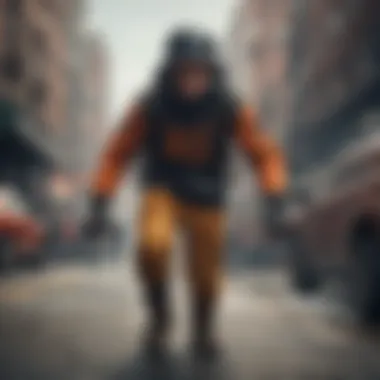The Evolution of Street Apparel in Extreme Sports


Intro
Street apparel has journeyed through various phases since it emerged at the intersection of fashion and athleticism. It is not just a clothing style; it reflects values, attitudes, and identities associated with extreme sports. The evolution of this attire parallels the rise of various extreme sports, including skateboarding, surfing, and BMX biking. This exploration provides insights into how streetwear represents more than just aesthetics. The cultural significance lies in its relationship with lifestyle, expression, and performance. Fashion and functionality merge in a space where thrill-seekers seek not only to look good but to embody a spirit of adventure.
Techniques and Tips
Skill Development
Gaining proficiency in extreme sports often requires dedication, practice, and the right gear. While clothing is essential, skills matter more. Each sport demands distinct techniques. For example, mastering a skateboard involves balance and timing, while surfing requires understanding waves. Prioritizing skill development is crucial.
Practical Techniques
Engaging with the right techniques enhances both performance and safety:
- Focus on balance and proper stance.
- Stay aware of environmental conditions.
- Incorporate drills to fine-tune skills regularly.
Common Mistakes to Avoid
As in any craft, newcomers often fall into specific traps that can hinder their progress. Some common mistakes include:
- Ignoring proper warm-ups.
- Overlooking safety gear.
- Underestimating the importance of physical fitness.
Gear and Equipment
Essential Gear for Beginners
For enthusiasts diving into extreme sports, having the right clothing and equipment is paramount. Basic gear includes:
- Board or Bike: Fundamental to the sport.
- Protective Gear: Helmets, knee pads, and wrist guards.
- Footwear: Specific shoes designed for grip and support.
Latest Innovations and Trends
The street apparel industry continually adapts to meet athlete needs. Recent innovations include enhanced moisture-wicking fabrics and technical materials that enhance performance without sacrificing style. Brands like Supreme and Off-White fuse aesthetics with high-functioning designs, creating a vibrant subculture within extreme sports.
Reviews and Comparisons
Evaluating gear effectiveness is vital. Key considerations include:
- Durability
- Comfort level
- Price vs. performance
Visit resources like Reddit for community-driven reviews.
Safety Measures
Essential Safety Gear
Safety cannot be ignored in extreme sports. Essential gear ensures a degree of protection against injuries. Key items include:
- Helmets
- Elbow and knee pads
- Appropriate footwear
Best Practices for Safe Participation
For a rewarding experience, following established safety practices is necessary. Some practices include:
- Inspecting gear pre-activity.
- Knowing your limits.
- Participating in a supervised environment when possible.
Injury Prevention and Management
Injuries can disrupt an athlete's journey. Minimizing risk involves:
- Regular fitness routines to build strength and flexibility.
- Warming up before activities.
- Rapd recovery strategies such as ice and rest after falls.
Spotlights on Extreme Sports
Featured Sport of the Month


This month, focus lies on skateboarding. The blend of athleticism and creativity sets it apart in extreme sports. Pushing boundaries through tricks is both an art form and a sport, shaping the culture of streetwear significantly.
Profiles of Prominent Athletes
Prominent athletes have influenced street apparel immensely. Their choices and styles inspire fans globally. Figures like Tony Hawk and Nyjah Huston showcase how personal branding in clothing complements their athletic achievements, enriching the streetwear narrative.
"Streetwear speaks to those who live for adventure and authenticity."
Understanding the evolution and impact of street apparel in extreme sports reveals its role in shaping identities and values. The relationship extends beyond mere clothing; it intertwines with lifestyle, culture, and athleticism.
Preface to Street Apparel Clothing
Street apparel clothing has gained noteworthy importance in the landscape of modern fashion, particularly within its relationship to extreme sports. The intersection of these two worlds presents an engaging narrative that not only outlines the evolution of clothing styles but also showcases how these styles reflect the identity and values of a specific subculture. Streetwear transcends basic fashion; it embodies attitudes, lifestyle choices, and even aspirational elements inherent in extreme sports communities. This article delves into the various facets involved, providing insights into the impact of street apparel on personal expression and the broader cultural dialogue.
Definition of Street Apparel
Street apparel, at its core, refers to casual clothing that often reflects urban life and youth culture. This term encompasses a wide array of garments including, but not limited to, hoodies, t-shirts, and baggy pants. The style is often characterized by its bold graphics, inventive designs, and the use of comfortable materials. Streetwear is important not only for its aesthetic appeal but also for its ability to serve as a canvas for personal identity. Individuals express themselves through what they wear, making style choices that resonate with their experiences and cultural affiliations.
Historical Context
To understand street apparel's present significance, one must consider its historical backdrop. The roots of streetwear can be traced back to the late 20th century, particularly within urban centers like New York, Los Angeles, and Tokyo. In these areas, clothing brands emerged from grassroots movements that found inspiration in skateboarding, hip-hop, and graffiti art. During the 1980s and 1990s, labels like Stüssy and Supreme began setting trends that combined functionality with a strong ethos. As extreme sports gained popularity, the clothing evolved alongside it. The blending of street apparel with extreme sports underlines how fashion trends can shift from niche markets to mainstream acceptance. The apparel not only became a symbol of rebellion but also a representation of a lifestyle tied to thrill-seeking and adventure.
Cultural Significance of Street Apparel
Street apparel holds a profound importance within the realm of extreme sports. It intertwines fashion with practicality, uniquely reflecting the values and attitudes of a diverse community engaged in high-adrenaline activities. Streetwear transcends mere clothing; it embodies a lifestyle that resonates with thrill-seekers and adventurous individuals. Understanding its cultural significance offers insights into the ongoing relationship between personal identity and the intense expressions of extreme sports.
Streetwear and Identity
Streetwear serves as a canvas for self-expression among extreme sports enthusiasts. It allows individuals to communicate their unique identities through fashion choices. The use of bold colors, graphic designs, and innovative materials not only captures the spirit of adrenaline but also sets individuals apart in a crowd. This clothing is not just about aesthetic appeal; it creates a sense of belonging among those who share an affinity for high-risk activities.
Moreover, streetwear can signify group affiliations. Different styles and brands may represent specific subcultures within the extreme sports scene. For instance, a specific brand can indicate a skateboarder's identity, while another can reflect the preferences of a mountain biker.
- Branding is key: Renowned brands like Supreme and Thrasher encapsulate the ethos of street culture, appealing specifically to those engaged in extreme sports.
- Conversation Starter: The choice of apparel can prompt conversations and connections, making it easier for individuals to bond over shared interests.
Influence of Music and Art
Music and art play a crucial role in shaping streetwear trends within extreme sports. Hip-hop culture, for instance, is heavily intertwined with street apparel. The images often portrayed in music videos and artworks inspire designs that impact the clothing industry. Artists who align themselves with extreme sports create a unique synergy that elevates both music and fashion.
The influence is bidirectional; as streetwear evolves, it, in turn, feeds back into music culture. Artists frequently incorporate elements of streetwear in their visuals, which can drive popularity and sales of specific apparel styles.
- Collaborations: Partnerships between artists and clothing brands lead to limited-edition drops, creating hype and a sense of exclusivity.
- Art in Apparel: Graphic tees often showcase artwork that reflects the adrenaline-fueled lifestyle, allowing wearers to display their interests beyond the sports they partake in.
"Streetwear is more than just fashion; it’s a movement that weaves together the lifestyles of music, art, and extreme sports."
In summary, street apparel not only plays a functional role but also chronicle the cultural moments that define contemporary society. Its significance goes far beyond utility, marking a definitive influence on personal identity and collective experiences in extreme sports.
Functional Aspects of Street Apparel in Extreme Sports
Understanding the functional aspects of street apparel clothing is essential in grasping its role within extreme sports. Performance and comfort are paramount, as these garments need to support athletes in strenuous activities. The connection between style and function is crucial; one cannot overshadow the other in the world of extreme sports. The ability to provide safety, flexibility, and breathability is a significant consideration when selecting clothing. The choice of fabric and design directly affects performance and ease of movement, making it vital for athletes to choose wisely.
Material Technology and Performance
Material technology plays a critical role in ensuring athletes get the best out of their apparel. Streetwear brands often incorporate advanced materials that enhance durability and flexibility. For instance, fabrics such as nylon, spandex, and polyester are commonly used due to their lightweight and stretchable properties. These materials support athletes in achieving maximum performance. Moreover, moisture-wicking technology is widely used in sports apparel. This helps to keep the athlete dry and comfortable, especially in demanding activities like skateboarding or snowboarding.
Utilizing materials that are resistant to wear and tear also adds longevity, which is essential for extreme sports enthusiasts who often push their gear to the limit. Seamless construction techniques further prevent chafing during high-intensity activities, a feature increasingly being implemented in street apparel.
Additionally, technological advancements have enabled brands to create breathable fabrics with ventilation zones that regulate temperature. This adaptability to different weather conditions is a significant benefit for athletes who partake in outdoor sports. These technical features collectively empower athletes to perform, offering functional supremacy that complements the streetwear aesthetic.
Design Aesthetics for Activity
Design aesthetics in street apparel are not just about appearance; they are intricately linked to functionality. The layout and fit of the clothing are tailored to accommodate active movements. Loose yet structured designs are essential for allowing freedom of movement while providing an appealing look. For instance, hoodies and baggy pants, popular in street apparel, are designed to offer comfort without compromising style.
Key features often include
- Reinforced stitches for added durability
- Expressive graphics that resonate with extreme sports culture
- Functional pockets that are strategically placed for usability during sport
Furthermore, the layering aspect of streetwear is relevant to extreme sports. Athletes often need to adjust their clothing according to changing weather conditions. Clothing that serves as both an outer layer and an inner garment allows for versatility on the move. The integration of street aesthetic with practical design ensures that wearers are both stylish and functional.


"Clothing in extreme sports merges functionality with street style to create an environment where athletes feel confident and capable."
Ultimately, the functional aspect of street apparel cannot be underestimated. From material choices to smart designs, every detail matters in optimizing an athlete's experience. The fusion of wearability and enthusiasm for urban culture signifies much more than fashion; it becomes a tool for expression and performance within extreme sports.
Key Styles in Street Apparel
In the context of extreme sports, the significance of key styles in street apparel cannot be understated. These styles not only represent a fashion choice but serve specific practical purposes for athletes engaging in high-energy activities. Understanding these styles provides insight into the intersection of street culture and extreme sports.
Hoodies and Graphic Tees
Hoodies and graphic tees epitomize the heart of streetwear fashion. Both garments offer a blend of comfort and style, essential for athletes who require flexibility and ease of movement. Hoodies, with their hoods and often oversized fit, protect against wind and cold, making them suitable for outdoor sports such as skateboarding and snowboarding. Meanwhile, graphic tees allow for personal expression. They often feature bold prints or logos that reflect an individual's interests or affiliations.
Some notable points regarding hoodies and graphic tees include:
- Versatility: These items can be dressed up or down, appealing to a variety of occasions, whether on the slopes or at social gatherings.
- Sponsorship and Branding: Many athletes wear items that feature their sponsors prominently, bridging the gap between personal expression and commercial promotion.
- Comfort: The fabrics used in these garments tend to be soft and breathable, crucial for maintaining comfort during extreme activities.
Graphic tees also foster community through shared imagery or slogans that resonate within the extreme sports culture. This reinforces a sense of belonging among enthusiasts.
"Streetwear is not merely clothing; it’s an identity woven into the fabric of a lifestyle."
Baggy Pants and Cargo Styles
Baggy pants and cargo styles have emerged as staples within street apparel worn by extreme sports athletes. These styles are defined by their loose fit, allowing for unrestricted movement, which is essential when engaging in activities such as BMX biking or climbing. The spacious cuts of these pants provide practical benefits, such as additional ventilation and comfort during intense workouts.
Key elements of baggy pants and cargo styles include:
- Functionality: Cargo pants typically feature multiple pockets, which are practical for storing small tools or personal items. This is particularly useful for athletes who need to carry essential gear while on the move.
- Durability: Many manufacturers design these pants from robust materials, ensuring they withstand wear and tear from extreme sports environments.
- Style Expression: Both baggy pants and cargo styles provide an opportunity for creativity. Athletes often customize their apparel, adding patches or personal designs that reflect their personality.
In summary, hoodies, graphic tees, baggy pants, and cargo styles all play a crucial role in defining street apparel within the extreme sports culture. These garments offer not just stylish options but cater to the unique needs of athletes enamored by activity-focused fashion.
The Intersection of Streetwear and Extreme Sports Communities
The intersection of streetwear and extreme sports communities is a pivotal topic in understanding the broader implications of style on lifestyles. This connection has not only shaped fashion trends but also amplified the cultural significance of street apparel in extreme sports. Streetwear is often seen as a reflection of youth culture, encapsulating attitudes of rebellion, freedom, and authenticity. When these values meet the adrenaline-driven world of extreme sports, they create a vibrant and dynamic cultural mix that goes beyond mere clothing.
Brand Collaborations and Sponsorships
Brands are increasingly recognizing the synergies between streetwear and extreme sports. Collaborations between streetwear brands and professional athletes or companies in the extreme sports sector have become commonplace. These partnerships amplify brand visibility while offering athletes a platform to express their personal styles. For example, the collaboration between Nike and skateboarding legend Paul Rodriguez has birthed a line of footwear that embodies both high performance and street credibility.
This type of partnership brings multiple benefits. Brands gain access to niche markets, engage with younger audiences, and enhance their cultural relevance. At the same time, athletes find a way to translate their lifestyle into a commercially viable products that resonates with their followers. The allure of unique designs and limited editions often drives sales, making these collaborations financially lucrative.
Influencers and their Role
Influencers play a critical role in bridging the gap between streetwear and extreme sports. Their online presence can shift public perception and spark trends. Influencers often embody both the spirit of extreme sports and the ethos of street fashion, blending them into their personal brands.
They create a narrative around products, showcasing how street apparel functions not only as gear, but as a lifestyle choice. For example, professional BMX rider Nigel Sylvester has carved a niche as both an athlete and a fashion influencer. His social media presence connects his trick riding skills with street style, merging both worlds for fans.
Through social media platforms, influencers can engage vast audiences, making them powerful marketing tools. Their endorsement often translates to significant sales and increased brand loyalty among followers who aspire to adopt similar styles. This interrelationship helps cultivate a community that values authenticity, lifestyle, and self-expression.
"The collaboration between streetwear and extreme sports blurs the lines of identity, creating a unique cultural phenomenon that resonates deeply with younger demographics."
Trends Reshaping Street Apparel Clothing
The street apparel industry does not exist in a vacuum. It constantly evolves. Trends are crucial in driving this progression, especially within the realm of extreme sports. These trends not only influence the aesthetic and functional attributes of streetwear but also reflect broader shifts in consumer behavior and values. Street apparel in extreme sports must merge style with substance, catering to performance needs while also resonating with cultural and ethical values.
Sustainable Practices in Streetwear
Sustainability is rapidly becoming a cornerstone of modern street apparel. This is particularly evident in extreme sports, where there is a growing awareness of environmental impacts. Brands are increasingly adopting sustainable practices, using recycled materials and ethical production methods. This gives consumers choices that align with their values. Signs of this can be seen in companies such as Patagonia, which emphasizes environmental responsibility in its production.
As it turns out, consumers favour brands that prioritize sustainability. This trend reshapes purchasing decisions. In extreme sports, where enthusiasts often participate in outdoor activities, a connection to nature amplifies the call for sustainable practices. The importance of eco-friendly materials, such as organic cotton or recycled polyester, emerges not only from ethical considerations but also from desires for durability and performance. More athletes are recognizing that sustainable apparel can meet their needs without compromising their principles.
"The streetwear movement is a fashion evolution that emphasizes individual values, such as sustainability—especially important in extreme sports."
Digital Fashion Innovations
Another significant trend impacting street apparel is digital fashion innovations. The rise of technology has made prominent changes in how apparel is designed, produced, and marketed. Virtual reality and augmented reality, for instance, allow consumers to try on clothing digitally, offering a new level of convenience. This is particularly appealing to younger demographics, including extreme sports enthusiasts who may shop online.


Additionally, collaborations between streetwear brands and technology companies lead to smarter apparel. Wearable technology, for instance, integrates performance monitoring into casual and sport-specific garments. These innovations create multifunctional clothing that supports extreme sports activities while keeping style on the forefront. More so, social media platforms enable brands to connect directly with their audiences, fostering communities around specific lifestyles and interests, further solidifying the relationship between streetwear and extreme sports.
Economic Impact of Street Apparel
The economic impact of street apparel is profound, particularly when considered within extreme sports. This sector has evolved beyond simple fashion into a significant cultural and economic phenomenon. The rise of street apparel is tied closely to how extreme sports, such as skateboarding and snowboarding, engage with fashion. Streetwear brands have become synonymous with these activities, enhancing brand visibility while fueling consumer engagement.
One specific element of this economic impact includes the revenue generation from various street apparel lines. Companies like Supreme and Palace Skateboards have established considerable market presence, offering unique designs that resonate with audiences and promote brand loyalty. Moreover, street apparel often commands higher price points due to its perceived value, uniqueness, and cultural relevance.
Another critical consideration is the influence on local economies. Many streetwear brands collaborate with local artists and designers, leading to the support of grassroots communities. This dynamic empowers individual creators while promoting local culture, which in turn stimulates economic growth.
Additionally, the expansion of street apparel into international markets creates new opportunities. As extreme sports continue to grow globally, so does the market for streetwear. This phenomenon allows brands to reach diverse audiences and adapt their strategies to fit global tastes.
Market Analysis and Trends
Market analysis reveals the complexities and dynamics of the street apparel industry. Growing numbers of young consumers are drawn toward brands that speak to their identities, driving market trends significantly. Currently, the streetwear market is worth billions, and its potential for growth remains high. Brands are adapting to shifts in consumer preferences, such as prioritizing sustainability and ethical production.
- Key trends impacting the market include:
- The rise in online shopping, with major platforms like Asos and Grailed leading the way.
- Increased focus on sustainability, prompting brands to invest in eco-friendly materials.
- Social media marketing strategies, where platforms like Instagram and TikTok amplify their reach.
Street apparel's market trends are closely intertwined with contemporary culture. The ever-evolving styles reflect the changing social attitudes, making the brands more adaptable and anticipatory of consumer needs. Keeping an eye on these trends is essential for brands aiming to maintain relevance and growth in the competitive landscape of street apparel.
Retail Strategies and E-Commerce
The retail strategies employed by street apparel brands highlight the shift towards e-commerce. Traditional retail avenues alone are no longer sufficient. Brands are leveraging online platforms, enhancing customer experience with user-friendly interfaces and personalized shopping options.
E-commerce has transformed the way consumers engage with streetwear. For instance, online exclusives and limited-time drops create urgency and excitement, prompting immediate purchases. Brands like Off-White and A Bathing Ape utilize these strategies effectively, leading to higher conversion rates.
- Key retail strategies include:
- Strong social media presence to drive traffic towards e-commerce sites.
- Collaborations with influencers for wider reach and credibility.
- Customer loyalty programs, incentivizing repeat purchases.
Furthermore, the integration of technology in retail, such as augmented reality fitting rooms, enhances consumer engagement and satisfaction. These advancements foster a more interactive shopping experience, ideal for the thrill-seekers and adventure lovers who dominate this culture.
In summary, the economic impact of street apparel is multifaceted, with each aspect contributing to a vibrant and evolving industry that intersects deeply with extreme sports.
Global Influence of Street Apparel
The global influence of street apparel plays a crucial role in understanding its evolution and impact on extreme sports. This influence extends beyond fashion, shaping identities, communities, and an entire cultural ethos surrounding extreme sports. The intersections of style and sport have generated a unique blend that resonates visually and philosophically with enthusiasts around the world.
Street apparel clothing is not only about the utility or comfort for extreme sports participants. It has become a symbol of rebellion, individuality, and a lifestyle choice. The bold colors, logos, and distinct cuts speak to a shared identity among thrill-seekers, creating a sense of belonging among diverse groups. This narrative showcases how streetwear has altered perceptions and norms across global markets.
Regional Variations and Adaptations
Street apparel has adapted to various regions, embracing local culture and trends. This regional variation is evident in the designs, color palettes, and material choices, reflecting each area's unique influence. For example, streetwear in Japan might incorporate a mix of traditional motifs and cutting-edge technology, whereas in South America, vibrant colors and patterns may dominate the landscape.
- Japan: Influenced by anime and street culture, result in distinct aesthetics.
- Europe: Urban settings give rise to minimalistic yet functional designs that adhere to the local climate.
- United States: Graffiti art and hip-hop culture profoundly impact the streetwear narrative.
These adaptations are essential as they demonstrate how local tastes and environments shape the overall perception of street apparel within extreme sports. The clothing becomes a canvas through which athletes express their cultural affiliations and alliances.
Cross-Cultural Influences
The global marketplace for street apparel thrives on cross-cultural influences that foster innovation and creativity. Fashion designers draw inspiration from various cultures, merging traditional elements with contemporary street style. Notably, this cross-pollination allows for the emergence of unique styles that combine influences from different parts of the world.
- Collaborations between mainstream brands and small local labels create hybrid styles, drawing from rich traditions and modern trends.
- Athletes often become cultural ambassadors, promoting these influences through their chosen sports.
- Social Media: Platforms like Instagram and Reddit play pivotal roles, showcasing international styles and trends that transcend borders.
"The blending of cultures in streetwear signifies more than just a trend; it's a representation of global unity and shared passion for adventure."
Through these cross-cultural exchanges, street apparel in extreme sports has become a mosaic of identities, highlighting a shared love for style and activity. This vibrant dynamic underscores the significance of street apparel as a globally influential medium that celebrates both diversity and unity in the extreme sports community.
Culmination
The exploration of street apparel clothing in extreme sports has illuminated its profound significance within both cultural and market contexts. This article underscores the notion that streetwear serves not only as a fashion choice but also as an embodiment of the attitudes and values prevalent within extreme sports culture. The interconnectedness of style and performance is not merely ancillary; it is central to how athletes and enthusiasts express their identities through their clothing.
Final Thoughts on Street Apparel
Street apparel has evolved into a powerful medium of self-expression and identity among extreme sports practitioners. It communicates community, lifestyle, and even aspirational values. Styles like hoodies, graphic tees, and baggy pants have transcended their functional use, becoming symbols of camaraderie and freedom. The rise of streetwear brands such as Supreme and Off-White further highlights this intersection, marrying bold aesthetics with the grit of extreme sports. As consumers, individuals are drawn not just to the aesthetics, but to the stories and cultures that these brands encapsulate.
Future Directions
Looking ahead, the evolution of street apparel in extreme sports will likely continue to reflect broader trends in society, including sustainability and technological integration. The increasing demand for environmentally responsible practices will shape brand strategies. Furthermore, digital innovations are also promising new ways for consumers to interact with brands, whether through virtual trials or limited-edition drops in digital ecosystems. The future of street apparel lies in its adaptability, as it prioritizes nuance in design while continuing to resonate with core values of the extreme sports culture.
The ongoing relationship between streetwear and extreme sports is more than material; it is a reflection of culture, identity, and innovation.







